Life on “The Hard” is a hard life!
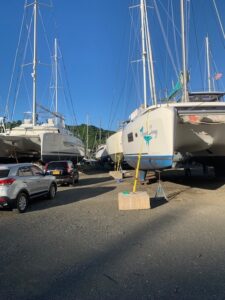
Blocked and on the hard before new paint job.
Ocean Song was hauled out at Clarke’s Court Boatyard (CC) on August 5th. As mentioned previously hauling out is stressful, there’s a lot that can go wrong. Our haul out was uneventful, just the way we like it. Once hauled it was into the yard, tucked in with many other boats. During the haul out we were planning to barrier coat and paint Ocean Song’s bottom (the portion of the hulls that are below the water line) and have all our engines and sail drives serviced. We also took our sails down to have them taken to a sail loft to be restitched and cleaned. The engine servicing is a big deal. Even though we are a sailboat, Ocean Song has three diesel engines: 2 – 57HP Yanmars for propulsion and a 13.5 Kw generator. We also have two sail drives which are the transmissions for the Yanmars. The sail drives transfer the horizonal rotation of our engines’ drive shafts and transmits it down at a 90-degree angle, then turns it another 90 degrees toward the stern of the boat. All the while, the sail drives also allow the props to shift from forward to reverse and vice-versa.
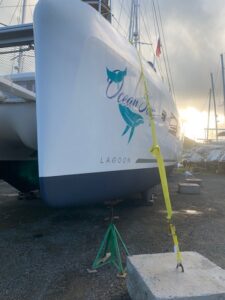
After new bottom paint.
A local Grenadian, Elroy Edmonds, had come highly recommended as a good person to paint the bottom of the boat. Initially, Linda and I had planned to do the work, but at the price Elroy quoted us that thought was soon forgotten. Elroy did a very, very good job. In fact, we were so happy with his work that we took Elroy and his girlfriend out for dinner as a “thank you”. Bottom painting is quite a science. The type of paint used depends on where the boat is located, how “mobile” the boat is, and what the previous bottom paint was. For example, if you don’t plan to travel very far ablative paint (which is formulated to slowly slough off) is often recommended. On the other hand, if the boat is on the move, hard paint is often recommended. Ablative paint can’t be painted directly over hard paint and hard paint can’t be painted directly over ablative paint – if one wants it to last. The best practice is to clean and sand the bottom, then put down a barrier coat. With a proper barrier coat in place virtually any paint can be painted over the previous paint job. Elroy put down a good barrier coat and we went with hard bottom paint, which is the type of bottom paint Ocean Song already had. Bottom paint is expensive, almost $500 US per gallon, so you want it done right!
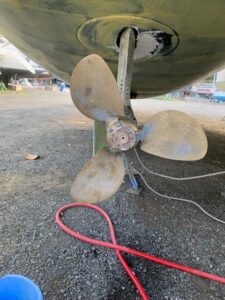
Prop before treatment.
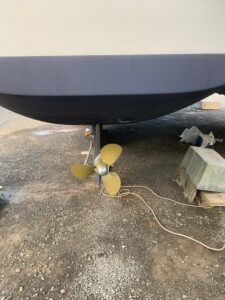
After prop treatment
Then there’s the “prop treatment”, a fancy term for prepping and painting the props and a small portion of the sail drives. Again, there’s a lot of science and chemistry involved, … and the paint for the props is more expensive than bottom paint, like 5 or 6 times more expensive. There’s a barrier coat, primer, and topcoat. Luckily, it takes less than a quart for both props!
Once the check engine alarm was sorted out, it was back to our mooring behind the reef outside Benji Bay. It felt like going home, being at anchor or on a mooring is much, much more comfortable than being on the hard. We highly recommend CC to anyone hauling out in Grenada. They have a massive boatlift, The Hulk. Yes, it’s big and green! CC uses divers at haul out to make sure the slings are properly placed (improperly placed slings are the major reason for haul out disasters). The yard workers were very helpful, especially Jose’, who really took care of us. Also, when we had the problem with the other boat’s paint staining Ocean Song, the yard manager went directly to the contractor and told him he HAD to clean our boat. The contractor was a reasonable South African fellow. At one point he did get a little frustrated and came to talk with us in the restaurant at CC. When we disagreed with his cleaning plan, he tried to walk away without acknowledging our opinion as to what needed to be done. One could tell he could be a bit of a bully, but we didn’t let him walk out on us. Jim literally stepped in front of him as he tried to walk away. We made him hear us out. We don’t get bullied easily! In the end, it worked out.
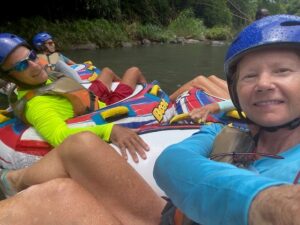
River tubing
Since being out of the boatyard we’ve gone river tubing, gone hashing (running and/or hiking in the mountains with beer and food at the finish), attended part of Grenada’s Carnival (very similar to Mardi Gras), and done small boat projects. Linda will do a separate post about some of these activities.

Carnival costumes modeled!

Hashing.
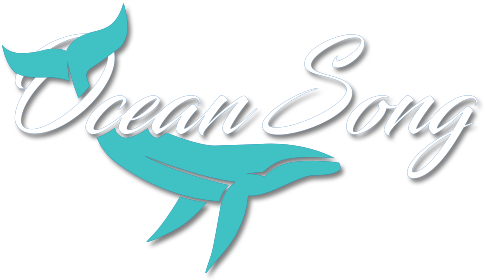
Leave a Reply